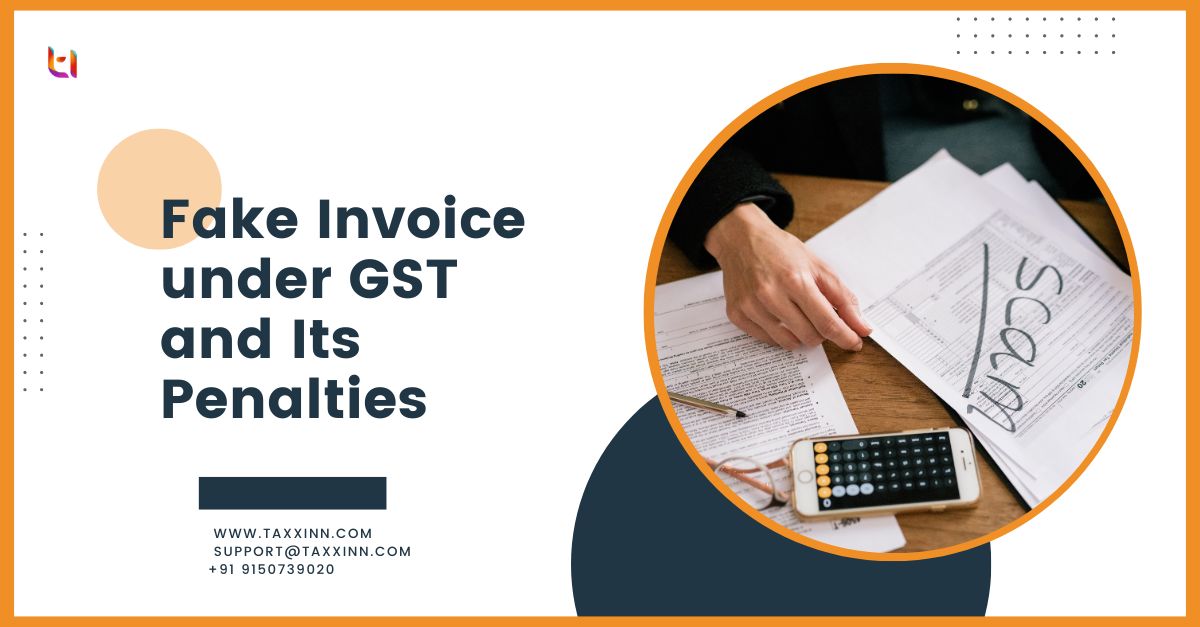Under GST law, fake invoices refer to invoices that are created and produced without any actual supply of goods or services. These invoices are often used for tax evasion or falsely claiming input tax credits. Fake invoices involve dishonest practices such as fabricating transactions, inflating prices, or misrepresenting goods/services in the market.
To streamline taxation and enhance compliance, India implemented the Goods and Services Tax (GST) system. However, this system faces a significant threat from fraudulent tactics like fake invoicing. In this blog, we will explore the concept of fake invoice gst penalty. Additionally, we will discuss the severe consequences imposed on individuals responsible for generating fraudulent invoices. By understanding the repercussions of these illegal activities, individuals and businesses can avoid engaging in such practices and contribute to the growth and progress of the country.
Different Cases of Fake Invoices Under GST
- One common occurrence involves the use of bogus and fake invoices.
- These invoices are employed to substantiate a fraudulent export refund.
- Another fraudulent practice involves generating a refund for Input Tax Credit (ITC) without actually providing any goods or services.
How Do Fraudsters Take Advantage of Fake GST Invoices?
The following are some ways that bogus fraudsters could abuse invoices according to the GST regime:
- They submit invoices for services or items that were never provided or for which the tax has already been paid, using an ineligible Input Tax Credit (ITC). In such cases, the invoice issuer falsely claims tax payments using a fake ITC. When the recipient of such an invoice uses the illegal ITC to pay taxes, it leads to revenue loss for the government.
- They change the recipient of goods or services to someone other than the intended individual. The recipient of such an invoice may use the ITC for GST payment during the export of goods and later claim a refund for the GST paid.
- They transfer bills among various bogus or dummy firms, manipulating the ITC movement to generate illicit profits. Despite no supply of goods or services, these invoices are subject to the regulations outlined in Rule 16 of the CGST Act of 2017, for eligibility of an ITC.
Obtaining an ITC without actually receiving the goods or services is strictly prohibited, and the government faces financial losses when such ITC is used for legitimate supplies. Essentially, fraudsters deceive the tax and banking systems by fabricating fraudulent e-way bills, creating false invoices through the GST system, and employing similar tactics to exploit the system.
To Detect a Fake GST Invoice, Follow These Steps:
- Verify that the invoice contains all the necessary information: A genuine GST invoice should include the supplier’s Goods and Services Tax Identification Number (GSTIN), name, and address. Ensure that all 16 mandatory fields are properly filled in.
- Confirm the applicable GST rate: Once you have validated the authenticity of the GSTIN, make sure you are eligible for the GST rate being charged by the supplier. You can cross-check the GST rate chart on the CBIC portal for accuracy.
- Compare with previous invoices: Another way to identify fake invoices is by comparing them to earlier invoices from the same supplier. Look for any differences in the provided information, product or service costs, or GST amounts. If you notice any significant discrepancies, it may indicate a fake invoice.
- Watch out for common warning signs: Familiarise yourself with the typical indicators of fake invoices. These may include unusually high or low prices, missing or inconsistent information, or demands for urgent payment. Stay alert to these red flags.
GST Penalty on Fake Invoices
Using fraudulent invoices to evade GST payments is a serious offence with severe penalties. It’s crucial to remember that these penalties apply to both the user and the producer of fake invoices. Even if a company unintentionally utilises a fake invoice, it can still be held accountable for the offence. Following the investigation, a Show Cause Notice (SCN) or other severe punishments may be issued. The Penalty for fake invoice in GST is listed below.
To address the challenges related to the imposition of demands and penalties in cases involving fraudulent invoices, the CBIC has issued GST Circular 171/2022.
| Input Tax Credits (ITC) or the Amount of Tax Avoided | Penalties |
| Engage in one of the above-mentioned offences, or urge someone else to engage in one. | A maximum of six months in jail sentence, a monetary penalty, or both of them. |
| More than Rs. 1 crore but less than Rs. 2 crore | A maximum of 3 years in a jail sentence and a monetary penalty. |
| More than Rs. 2 crore but less than Rs. 5 crore | A maximum of 3 years in a jail sentence and a monetary penalty. |
| If the taxpayer has produced fake invoices to claim an ITC value exceeding Rs. 5 crores. | A monetary punishment and a maximum 5-year jail sentence. |
Conclusion
In conclusion, fraudulent billing is a dishonest strategy that’s enforced to take advantage of the GST system. The penalties and imprisonment connected with similar conduct aim to discourage fraudulent conduct and uphold the credibility of the revenue system. To help falling into the trap of fake billing information, businesses must emphasise transparency, exactness, and compliance. Businesses should avoid legal issues and support a transparent and effective tax system by staying up to date on GST legislation, performing periodic audits, and maintaining detailed records. At Taxxinn, we help you to file the GST through a hassle-free process.
Related Reads:
What is GST Composition Scheme? Key Features and Eligibility Rules
Complete List of Legal Requirements Before Starting Your Company.


